Detroit’s Riley Arthur wins Camera USA 2019 National Photography Competition
 Last Friday (May 31), the Naples Art Association announced that Riley Arthur of Detroit, Michigan won its 2019 Camera USA National Photography Competition and a $5,000 cash prize. Her winning image is titled Golden Hour at Joe Juniors. It’s a tantalizing picture of a Manhattan diner bathed in the glow of late afternoon sunlight at the 5:00 hour, in that pregnant lull before the start of the
Last Friday (May 31), the Naples Art Association announced that Riley Arthur of Detroit, Michigan won its 2019 Camera USA National Photography Competition and a $5,000 cash prize. Her winning image is titled Golden Hour at Joe Juniors. It’s a tantalizing picture of a Manhattan diner bathed in the glow of late afternoon sunlight at the 5:00 hour, in that pregnant lull before the start of the  dinner rush.
dinner rush.
“Joe Juniors diner in Manhattan has been around for more than 30 years which, in the grand scheme of things, isn’t a long time,” Arthur explained, clearly enjoying the afterglow that accompanied the announcement of her victory in the competition, which included 239 submissions from across the U.S.A. “But for a restaurant in Manhattan, with rising costs and rents, changing tastes and 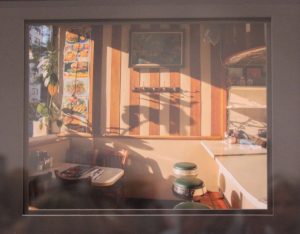 shrinking profit margins, it’s quite a feat.”
shrinking profit margins, it’s quite a feat.”
The diner has been described by reviewers as both “an awesome greasy spoon” and “an oasis in the desert of luxury condos, bank branches, and 2 bite fusion tapas dish restaurants.” Eater.com’s and NYC resident carnivore Nick Solares said in 2015 that Joe Junior serves the best hamburger in NYC – a densely charred, craggy-crusted burger 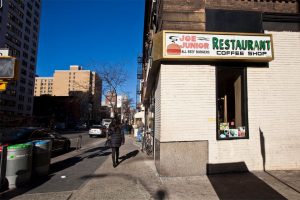 “that only aspires to feed the belly but ends up feeding the soul … nostalgia incarnate … the platonic ideal of what a diner burger should be.”
“that only aspires to feed the belly but ends up feeding the soul … nostalgia incarnate … the platonic ideal of what a diner burger should be.”
As delicious and Zen-like as that may be, it is not why Arthur snapped her award-winning photograph of Joe Junior.
“The 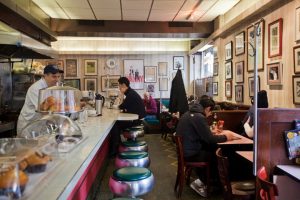 photograph fits into a larger project, which is me documenting the diners of New York City,” Riley explains matter-of-factly. “When I started the project, I realized there are some beautiful diners like Joe Junior that have this historic look, but I didn’t realize how endangered New York City diners really are. I quickly noticed a trend of many diners closing in quick succession. So I decided I had to expand the project
photograph fits into a larger project, which is me documenting the diners of New York City,” Riley explains matter-of-factly. “When I started the project, I realized there are some beautiful diners like Joe Junior that have this historic look, but I didn’t realize how endangered New York City diners really are. I quickly noticed a trend of many diners closing in quick succession. So I decided I had to expand the project 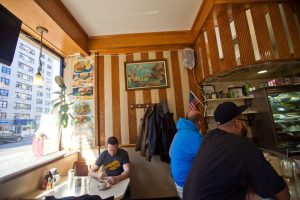 to encompass all the diners in New York City [not just the historic ones], not realizing that there are over 400 diners in the five boroughs.” [In this regard, Arthur concedes that the traditional textbook definition of “diner” is restricted to prefabricated buildings built in a factory that can be moved from one lot to another. But to her way of thinking, any eaterie that contains the word “diner” in it qualifies –
to encompass all the diners in New York City [not just the historic ones], not realizing that there are over 400 diners in the five boroughs.” [In this regard, Arthur concedes that the traditional textbook definition of “diner” is restricted to prefabricated buildings built in a factory that can be moved from one lot to another. But to her way of thinking, any eaterie that contains the word “diner” in it qualifies – 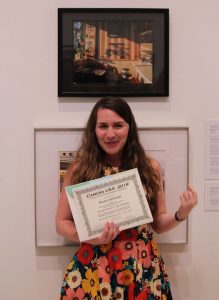 “you know it when you’re in a diner,” Riley chuckles, her mouth widening into a broad grin.]
“you know it when you’re in a diner,” Riley chuckles, her mouth widening into a broad grin.]
The diner is an icon of American culture. You’ll find at least one in every American town and city. With more than 600, New Jersey has bragging rights as diner capital of the world. But, interestingly, there wasn’t a single diner where Riley grew up.
“I’m from American Samoa, an island and U.S. territory in the South Pacific which has zero diners.”
So how did a diminutive (in physique, not talent) girl from American Samoa decide to launch a  3-year project photographing every diner she could find in New York City’s five boroughs?
3-year project photographing every diner she could find in New York City’s five boroughs?
“I lived for a time in Queens,” Riley deadpanned, still clutching the certificate that Naples Art Association Executive Director Aimee Schlehr handed her.
There was a 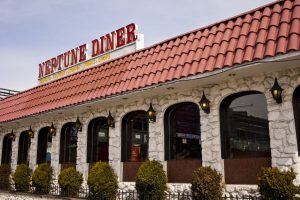 diner on Astoria a short walk away from her apartment called Neptune.
diner on Astoria a short walk away from her apartment called Neptune.
“It just stuck out like a sore thumb because it’s from another era.”
The diner signed a 35-year lease in 1984, which is set to expire on August 31, 2019. With no extension options, the Neptune and two adjacent lots are 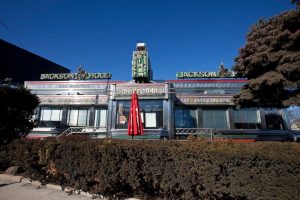 listed for sale at more than $10 million. It’s a sign of the times.
listed for sale at more than $10 million. It’s a sign of the times.
“Recognized the world over as a symbol of kitsch Americana, the once inescapable restaurants are increasingly disappearing,” notes Arthur in the Artist Statement that accompanies Golden Hour at Joe Juniors. “Globalization, homogenization, hyper gentrification, 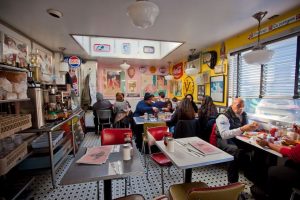 rising costs and changing tastes are obliterating small businesses including diners. This is part of a global trend, with cities fighting to maintain their identities.”
rising costs and changing tastes are obliterating small businesses including diners. This is part of a global trend, with cities fighting to maintain their identities.”
As soon as she moved into the neighborhood, Riley knew she wanted to photograph it.
But she didn’t.
However, now sensitized to these bastions of popular culture, Riley began noticing and photographing other historic diners around the city.
“I started doing research, as any photographer does on a big project. Like who else is doing this? Who else can I talk to? And 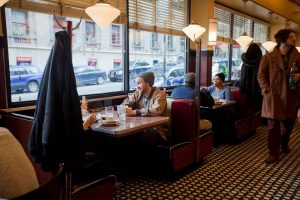 no other photographer was photographing diners at the time, so I thought ‘It might as well be me.’”
no other photographer was photographing diners at the time, so I thought ‘It might as well be me.’”
The project took off from there.
In fact, it took on a life of its own, which has continued even though Riley has since left Queens and the New York City metropolitan area.
“I 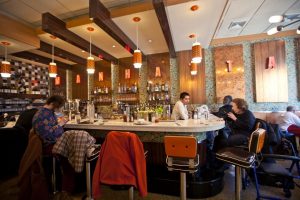 only get to visit three or four times a year. But I make the most of it when I’m there. I can visit 40 diners in a week. Of course, that’s all I’m doing, but I can do 40 in a week.”
only get to visit three or four times a year. But I make the most of it when I’m there. I can visit 40 diners in a week. Of course, that’s all I’m doing, but I can do 40 in a week.”
She’s visited as many as 14 in a single day.
“Some people go on pub crawls. I go on diner crawls,” she laughs.
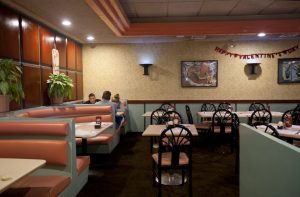 Although some are located in such out-of-the-way spots that she’s had to rent a car and drive to them, most are accessible by public transportation.
Although some are located in such out-of-the-way spots that she’s had to rent a car and drive to them, most are accessible by public transportation.
“That can take considerably longer because buses in New York are notoriously unreliable and on the weekends the trains don’t run as regularly as on weekdays. It can take three hours round trip to go to a single diner that’s way out in deep Queens.”
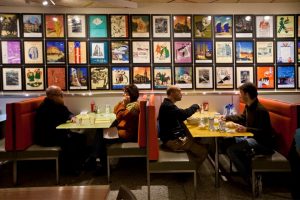 But that’s precisely what she does.
But that’s precisely what she does.
To locate diners, she employs a combination of resources, including Google Maps and Yelp.
“Sometimes I’ll spend an hour and half to get some place only to find it’s closed. So I photograph the exterior and do whatever else I can.”
And for the most part, it’s an individual pursuit, done primarily 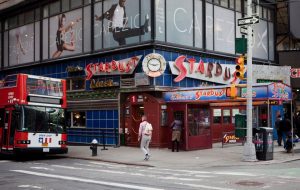 on foot alone in neighborhoods that many consider sketchy.
on foot alone in neighborhoods that many consider sketchy.
“I’ve had NYC undercover policemen say, ‘Next time you go to Brownsville or Canarsie, contact me and I’ll get you a police escort. You cannot be going into these neighborhoods by yourself’”
But she goes it alone anyway.
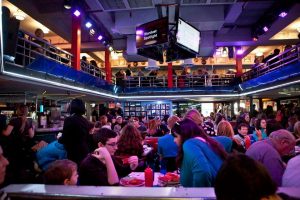 “I don’t want to be encumbered.”
“I don’t want to be encumbered.”
And, fortunately, she hasn’t experienced any issues so far.
“But I’ve seen more of New York City than most lifelong residents ever have or will.”
For example, she’s been to City Island (off the Bronx) twice.
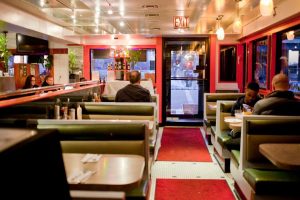 “It’s a little fishing village that looks like New Hampshire.”
“It’s a little fishing village that looks like New Hampshire.”
Arthur is driven like the G Train in her ongoing quest to photodocument every diner in the city by two parallel tracks. One is historic, the other humanistic.
Riley is keenly aware that, like the Neptune, the diner is in 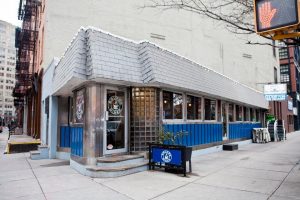 danger of becoming extinct. Historically, the concept dates back to 1872, when a Rhode Island printer by the name of Walter Scott began serving sandwiches, eggs, pies and coffee to people late at night out of a repurposed horse-drawn wagon. Within no time, lunch wagons and diners began popping up all over the northeast.
danger of becoming extinct. Historically, the concept dates back to 1872, when a Rhode Island printer by the name of Walter Scott began serving sandwiches, eggs, pies and coffee to people late at night out of a repurposed horse-drawn wagon. Within no time, lunch wagons and diners began popping up all over the northeast.
In 1913, 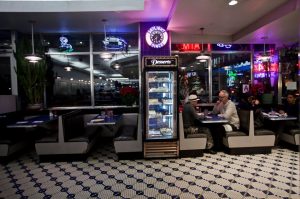 Jerry Mahoney introduced the first stationary diner. They proliferated after World War I, and really appealed to the hordes of GIs returning home from both the European and Pacific Theaters in the summer and fall of 1945. By the 1950s, Mahoney owned more than 6,000 diners nationwide.
Jerry Mahoney introduced the first stationary diner. They proliferated after World War I, and really appealed to the hordes of GIs returning home from both the European and Pacific Theaters in the summer and fall of 1945. By the 1950s, Mahoney owned more than 6,000 diners nationwide.
Today, 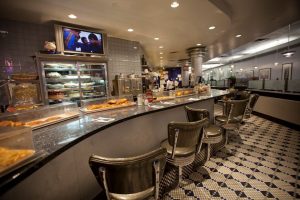 the diner’s role as a cultural icon is indisputable. “It is a setting in acclaimed films like Pulp Fiction and When Harry Met Sally, television sitcoms and series like Happy Days and Twin Peaks, some of the greatest novels of the 20th century, and even paintings by Edward Hopper and Normal Rockwell,” writes Joan Russell for Paste in 2016. (In fact, the mere mention of the word diner
the diner’s role as a cultural icon is indisputable. “It is a setting in acclaimed films like Pulp Fiction and When Harry Met Sally, television sitcoms and series like Happy Days and Twin Peaks, some of the greatest novels of the 20th century, and even paintings by Edward Hopper and Normal Rockwell,” writes Joan Russell for Paste in 2016. (In fact, the mere mention of the word diner 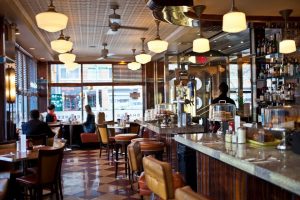 conjures images of Hopper’s Nighthawks in most people’s minds.) The Johnson & Wales Culinary Museum in Rhode Island even has a collection of more than 250 photos of stainless steel diners, floor plans and notes made by the builders who designed them.
conjures images of Hopper’s Nighthawks in most people’s minds.) The Johnson & Wales Culinary Museum in Rhode Island even has a collection of more than 250 photos of stainless steel diners, floor plans and notes made by the builders who designed them.
Recognizing that diners are particularly threatened in New York City, 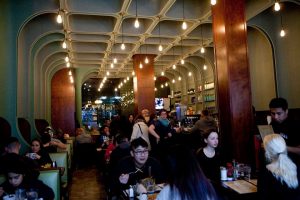 where their numbers have plummeted and this “dynamic part of the city’s fabric is dying,” she’s become obsessed with documenting this fast-fading segment of the American zeitgeist before it disappears forever. And with that goal firmly in mind, she is assiduously collecting memorabilia, menus, owner interviews and patron profiles in addition to the photos she takes. And as a photo-
where their numbers have plummeted and this “dynamic part of the city’s fabric is dying,” she’s become obsessed with documenting this fast-fading segment of the American zeitgeist before it disappears forever. And with that goal firmly in mind, she is assiduously collecting memorabilia, menus, owner interviews and patron profiles in addition to the photos she takes. And as a photo-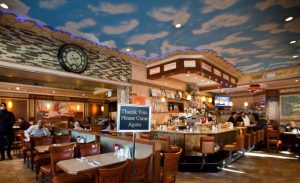 documentarian, she fastidiously avoids posing anyone or otherwise staging any of her shots.
documentarian, she fastidiously avoids posing anyone or otherwise staging any of her shots.
“They are simply a moment in time at a single diner.”
That said, some of the owners she’s met over the past three years 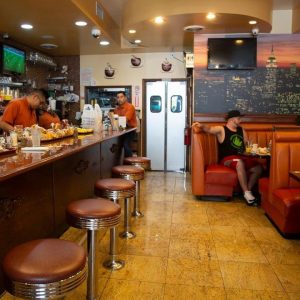 have begged Riley to take their pictures and include them in her body of work. And that informs the humanistic side of her project.
have begged Riley to take their pictures and include them in her body of work. And that informs the humanistic side of her project.
“I typically go in as an unassuming customer, but most [of the proprietors] are delighted to have me. Their life’s work is in that establishment! They’ve put in 14 hour days seven days a week for 40 years. So when someone shows a passion for diners, they won’t let you leave.
“Diners 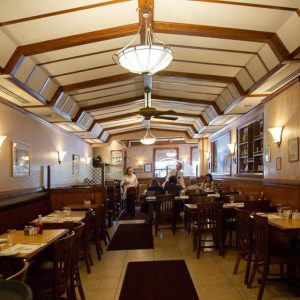 are often immigrant success stories, the majority owned by Greek immigrants,” Riley notes.
are often immigrant success stories, the majority owned by Greek immigrants,” Riley notes.
But in the end, Arthur is trying to capture the whole diner experience. “The goal is to get a picture that really encapsulates what the diner experience is at that particular establishment. That’s so memorable it burns into your brain [like Hopper’s Nighthawks]. I’m trying to take pictures that people can connect with so that even if they haven’t gone to that diner, they feel like they’ve 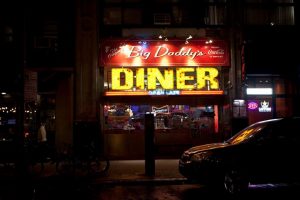 been there.”
been there.”
“In the end, if I can get someone to patronize a small family business that they wouldn’t have otherwise visited, I’ve done my job,” says Riley modestly.
And people have done that!
“People have gone out of their way to go to a diner because they saw it 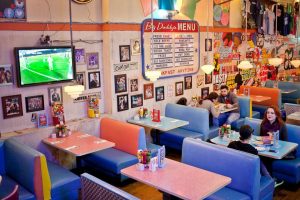 on my Instagram account, dinersofnyc,” she says with wonderment in her voice. “Of course, I didn’t start out to be a diner expert or a Trip Advisor for NYC diners, but along the way it’s sort of accidentally evolved into that.”
on my Instagram account, dinersofnyc,” she says with wonderment in her voice. “Of course, I didn’t start out to be a diner expert or a Trip Advisor for NYC diners, but along the way it’s sort of accidentally evolved into that.”
Yet, Riley has bigger long-range plans.
While The New York Times has covered the project twice 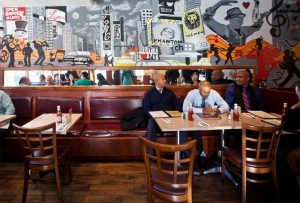 The Guardian, Huffington Post and other outlets have published some of her photos, Riley’s overarching hope is to publish a coffee table book or even produce a documentary on NYC diners and the diner experience.
The Guardian, Huffington Post and other outlets have published some of her photos, Riley’s overarching hope is to publish a coffee table book or even produce a documentary on NYC diners and the diner experience.
But at the opening reception of Camera USA 2019, it was all about basking in the glow of a well-deserved win.
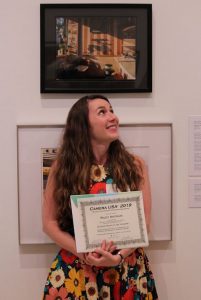 Congratulations to you, Riley Arthur for your National Photography Competition win.
Congratulations to you, Riley Arthur for your National Photography Competition win.
The NAA’s 2019 Camera USA National Photography Exhibition is on view in the ground floor galleries through July 5, 2019.
June 5, 2019.













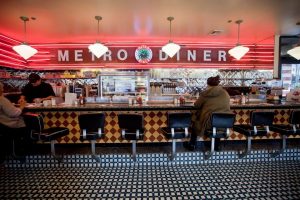

 Tom Hall is both an amateur artist and aspiring novelist who writes art quest thrillers. He is in the final stages of completing his debut novel titled "Art Detective," a story that fictionalizes the discovery of the fabled billion-dollar Impressionist collection of Parisian art dealer Josse Bernheim-Jeune, thought by many to have perished during World War II when the collection's hiding place, Castle de Rastignac in southern France, was destroyed by the Wehrmacht in reprisal for attacks made by members of the Resistance operating in the area. A former tax attorney, Tom holds a bachelor's degree as well as both a juris doctorate and masters of laws in taxation from the University of Florida. Tom lives in Estero, Florida with his fiancee, Connie, and their four cats.
Tom Hall is both an amateur artist and aspiring novelist who writes art quest thrillers. He is in the final stages of completing his debut novel titled "Art Detective," a story that fictionalizes the discovery of the fabled billion-dollar Impressionist collection of Parisian art dealer Josse Bernheim-Jeune, thought by many to have perished during World War II when the collection's hiding place, Castle de Rastignac in southern France, was destroyed by the Wehrmacht in reprisal for attacks made by members of the Resistance operating in the area. A former tax attorney, Tom holds a bachelor's degree as well as both a juris doctorate and masters of laws in taxation from the University of Florida. Tom lives in Estero, Florida with his fiancee, Connie, and their four cats.